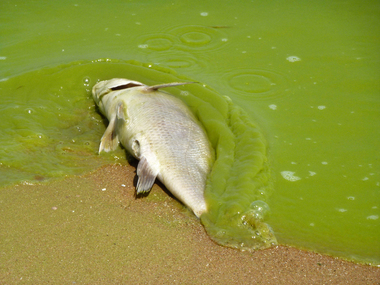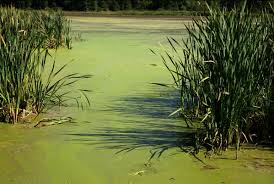Fertilizers, nutrients on land too much of good thing in water
Janine H. Rybka and Patricia Carey
After years of celebrating the revival of Lake Erie, which meant cleaner water, great fishing and recreational opportunities, it  appears that our blue lake is turning green — and not in a good way.The 1972 Clean Water Act led to visible water quality improvements in the Cuyahoga River and Lake Erie. Fish and small aquatic animal populations slowly rebounded as a result of pollution controls on industry, better wastewater treatment and reduced phosphorus levels in cleaning products.Now, water quality levels are decreasing and the alarm bells are ringing again.The Western Basin of Lake Erie, located roughly from Toledo to Huron, is becoming seriously affected with toxic blue-green algae. During the summer months, the algal blooms have been so bad that swimmers have emerged from Lake Erie covered in green slime. So far, swimming in Lake Erie has not been prohibited as it was in Grand Lake St. Mary’s, however, the thick algal blooms are not very inviting to swimmers and tends to affect the taste of our drinking water.The enjoyment of Lake Erie for boating and fishing has also become hampered by the costs to repair clogged engines and the costs of reduced economic drivers, such as fishing charters and other recreational opportunities. We are dangerously close to severely restricting our use and enjoyment of one of the world’s greatest natural resources.
appears that our blue lake is turning green — and not in a good way.The 1972 Clean Water Act led to visible water quality improvements in the Cuyahoga River and Lake Erie. Fish and small aquatic animal populations slowly rebounded as a result of pollution controls on industry, better wastewater treatment and reduced phosphorus levels in cleaning products.Now, water quality levels are decreasing and the alarm bells are ringing again.The Western Basin of Lake Erie, located roughly from Toledo to Huron, is becoming seriously affected with toxic blue-green algae. During the summer months, the algal blooms have been so bad that swimmers have emerged from Lake Erie covered in green slime. So far, swimming in Lake Erie has not been prohibited as it was in Grand Lake St. Mary’s, however, the thick algal blooms are not very inviting to swimmers and tends to affect the taste of our drinking water.The enjoyment of Lake Erie for boating and fishing has also become hampered by the costs to repair clogged engines and the costs of reduced economic drivers, such as fishing charters and other recreational opportunities. We are dangerously close to severely restricting our use and enjoyment of one of the world’s greatest natural resources.
This issue is getting regional and national attention. The Plain Dealer has reported that among the likely causes of increased algal blooms are current farming conditions and a change in weather, including more intense storms.
Michael Wines of The New York Times decried that “Lake Erie is Sick” with algae that, in 2011, covered one-sixth of its waters. The algae, while fouling beaches and reducing fish populations due to decreased oxygen levels, contribute to an expanding dead zone in the lake’s bottom, altogether crippling a tourism industry that generates more than $10 billion in revenue annually.
This dramatic decline is the result of too many nutrients running off the land. Nutrients found in fertilizers are necessary for crop and plant growth. But excessive nutrients cause excessive growth of algae in rivers and lakes. Reducing the amount of fertilizers running off the land will take a concerted effort by rural — and urban and suburban — landowners to remedy this problem.
Here are some statistics showing why action is needed now:
• Eleven million people rely on Lake Erie for drinking water.
• Tourism in Ohio generates more than $10 billion annually, supporting 117,000 jobs.
• Current levels of walleye caught in the lake are one-fifth of past catches, according to an Environmental Protection Agency report.
• The number of charter fishing companies has dropped 40 percent.
 Ohio’s Soil and Water Conservation Districts (SWCDs) have a long history of working with landowners on issues related to erosion, sediment control and water quality. Seven county-based SWCDs in Northeast Ohio are now jointly tackling the issue of nutrient runoff before it becomes a major crisis in the Central Basin of Lake Erie, off the shore of Northeast Ohio.
Ohio’s Soil and Water Conservation Districts (SWCDs) have a long history of working with landowners on issues related to erosion, sediment control and water quality. Seven county-based SWCDs in Northeast Ohio are now jointly tackling the issue of nutrient runoff before it becomes a major crisis in the Central Basin of Lake Erie, off the shore of Northeast Ohio.
An information campaign aimed at urban, suburban and rural landowners will address how landowners can meet their “green” goals while reducing costs and protecting our main source of drinking water. The campaign will promote good practices, such as:
• The use of established best management practices (BMPs) on public lands, including parks and golf courses.
• Implementation of BMPs to reduce erosion and to control sediment on construction sites where sediment runoff can be more than 200 percent greater by area, although not volume, than sediment runoff from agricultural lands.
• Encouraging landowners, including residential owners, to test their soils through local garden centers or established testing labs before adding fertilizers. Interestingly, it has been demonstrated that Ohio soils already have high levels of phosphorous.
• And the most basic of recommendations: P.U.P., or “Pick Up the Poop” from your pet.
A concerted effort by all Lake Erie stakeholders will be necessary to prevent further environmental and economic impairments. The overall health of Lake Erie is something we all need to protect.
Janine J. Rybka is the district administrator and Patricia Carey is supervisor of the Cuyahoga Soil and Water Conservation District.




